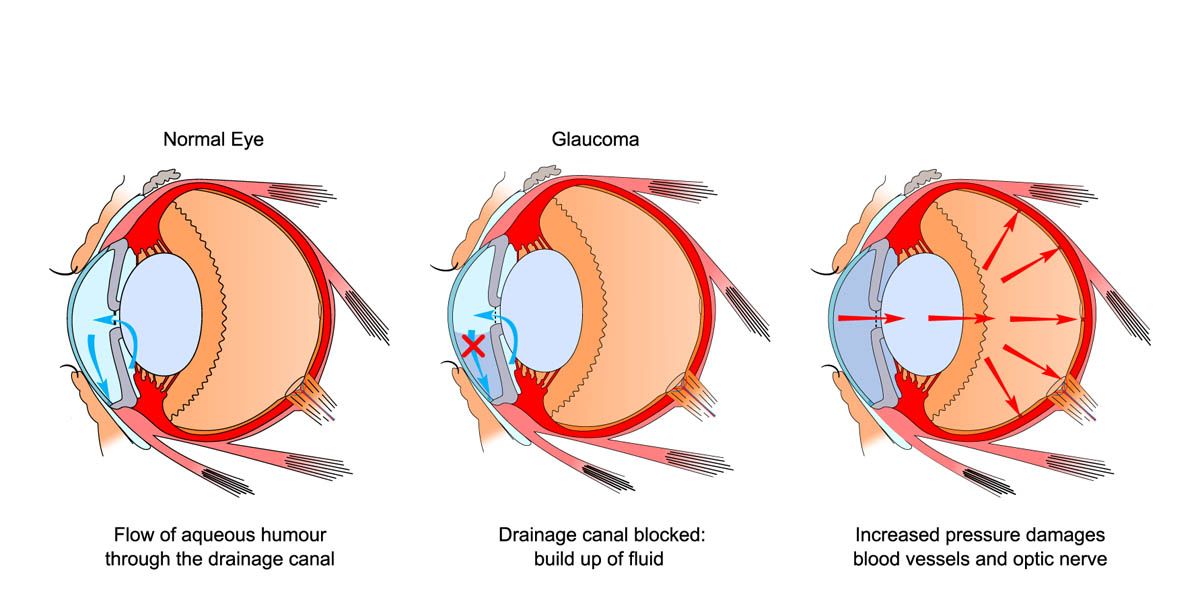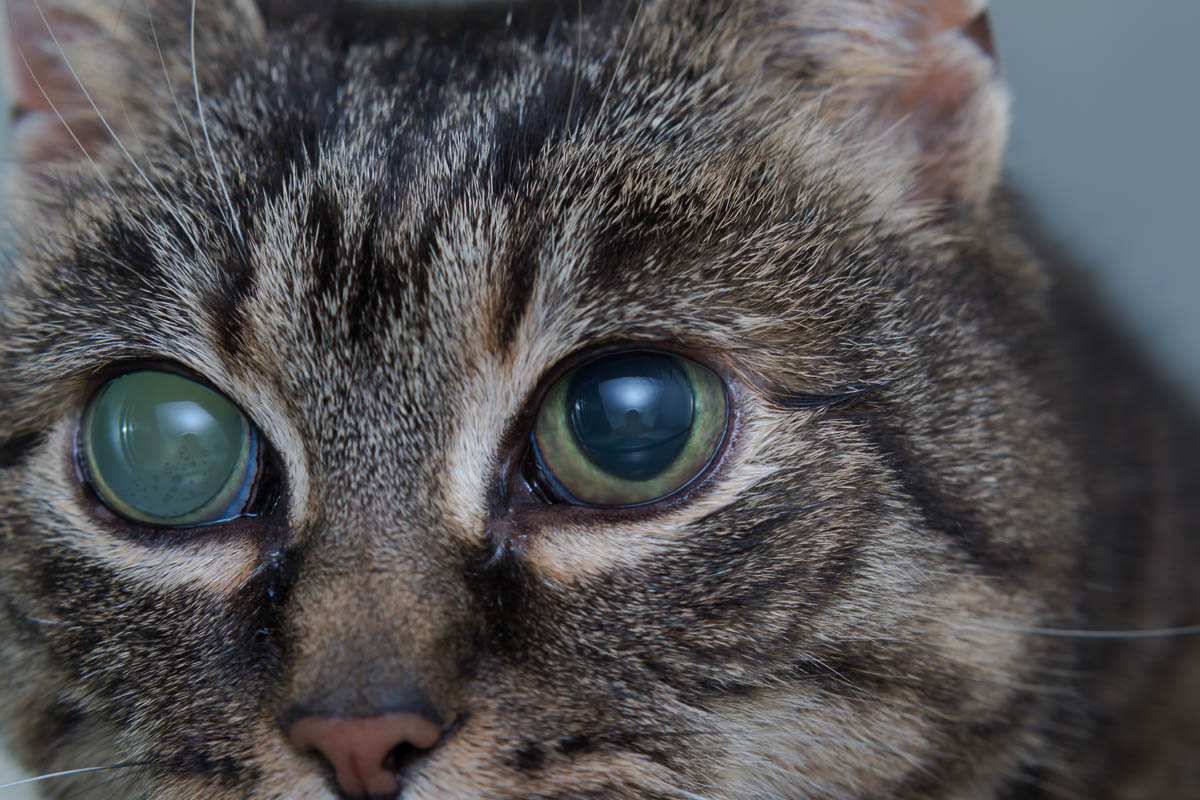At a glance
|
What is glaucoma?
Also known as hard eye, glaucoma is a group of eye diseases where vision is lost due to damage to the optic nerve. The most common cause is an increase in intraocular pressure (IOP) in the eye. The eye contains a transparent water-like fluid known as intraocular fluid or aqueous humor, which maintains the shape of the eye and provides nutrition and oxygen to the lens and cornea and removes metabolic waste.
The ciliary epithelium produces intraocular fluid, which drains away at the drainage angle where the iris and cornea meet, exiting via a series of drainage canals (trabecular meshwork) and is reabsorbed into the bloodstream. This fluid in/fluid out should occur at the same rate, to keep pressure within the eye stable. If the outward flow of fluid is reduced or blocked, a build-up occurs leading to an increase in intraocular pressure. This fluid build-up pushes against the internal structures of the eye and puts pressure on the optic nerve which transmits visual information from the retina to the brain. Damage to the optic nerve causes a progressive and eventual vision loss in the affected eye(s). The Veterinary Medical Database found glaucoma causes a loss of vision in 1 in 367 cats.
Primary and secondary glaucoma
Glaucoma can be primary or secondary and can affect one eye (unilateral) or both eyes (bilateral).
- Primary glaucoma is rare in cats occurring most often in Siamese, Burmese, and Persian cats due to a congenital eye abnormality in the drainage angle. Primary glaucoma usually starts in one eye but eventually affects both eyes.
- Secondary glaucoma occurs when another eye or systemic disease is present and is responsible for 95-98% of feline glaucoma cases, it can affect one or both eyes.

Types of glaucoma
Glaucoma comes in two forms, open-angle, and closed-angle.
- Open-angle (wide-angle) glaucoma is the most common type and is caused by a slow and progressive partially clogging of the trabecular meshwork and slowing down the drainage of the aqueous humour.
- Closed-angle (angle-closure) glaucoma occurs when the iris bulges forward completely clogging access to the trabecular network. This is by far the most serious type of glaucoma as the pressure can rise very quickly.

Causes
Glaucoma is a slow and progressive disease secondary to several disease processes. The most common cause is uveitis (inflammation of the uvea) which leads to a build-up of protein deposits and debris which block the drainage angle. Middle-aged cats are over-represented, with a mean age of mean 7.6 years.
- Trauma and intraocular hemorrhage
- Lens rupture
- Anterior displacement of the lens (lens luxation)
- Severe intra-ocular infections
- Ocular tumours are common in cats, iris melanomas, post-traumatic sarcomas, iridociliary
adenocarcinomas and lymphoma are the most common
Clinical signs

Glaucoma is known as the ‘thief of sight’ because sight loss occurs gradually and cats with chronic glaucoma may not display clinical sign until the disease is at an advanced stage. Signs of glaucoma can develop quickly in cats with acute glaucoma, but due to their stoic nature, symptoms may not be obvious in cats with chronic glaucoma until the diseases has progressed.
Unfortunately, routine veterinary visits don’t include tonometry (a measure of ocular pressure), which is performed on humans during routine eye tests with an optometrist (optician). One study found 73% of glaucomatous cats were already blind at the time of initial presentation.
Clinical signs:
- Bulging, enlarged eye (due to reduced drainage of aqueous humour, this can be especially dramatic in young cats)
- Squinting
- Prominent blood vessels in the white of the eye
- Dilated pupil which is unresponsive to light
- Cloudiness
- Blue hue to the cornea, the transparent part of the eye
- Loss of vision
Diagnosis
The veterinarian will perform a complete physical examination of your cat and obtain a medical history from you. He will need to perform some diagnostic tests first to determine if the glaucoma is primary or secondary. If glaucoma is secondary (as it almost always is), it is critical to look for an underlying cause.
The veterinarian may refer the cat to a veterinary ophthalmologist (a veterinarian who specialises in eye and vision care).
Diagnostic workup:
- Baseline tests: To evaluate the overall health of the cat and check for diabetes with a biochemical profile, complete blood count, and urinalysis.
- Tonometry: Measurement of the intraocular pressure. Eye drops are applied to the eye(s) to numb them, then a tonometer is used to gently press the cat’s eye to determine how much force is required to flatten the cornea. The eye is harder (which means a higher pressure) in cats with glaucoma. Normal intraocular pressure in cats is 18.4 (±0.67) mm Hg.
- Gonioscopy: A gonioscope is an instrument that consists of a magnifier and a lens equipped with mirrors and is placed on the cornea to evaluate the drainage network to look for signs of blockage.
- Ophthalmoscopy: The veterinarian uses a handheld device known as an ophthalmoscope to look through the pupil and examine the back of the eye.
- Eye ultrasonography: A topical antiseptic is applied to the eye and ultrasound gel is applied to the eyelids. an ultrasound probe is placed on the eyelids which provides a detailed picture of the interior of the eye, this can help the veterinarian evaluate for tumours, lens displacement, trauma.
- Optical coherence tomography (OCT): A computerised ultrasound measures the thickness of the retinal nerve fibres.
- Fluorescein: A yellow stain is applied to the eye to check for corneal ulcers.
- Feline immunodeficiency virus and Feline leukemia antigen tests: To evaluate for these viral infections
Treatment
Unfortunately, glaucoma is incurable but it can be managed. Treatment of glaucoma is twofold, address the underlying cause and reduce ocular pressure by either decreasing production of aqueous humor or increasing drainage.
Medical therapy:
There are several eye drops and medications to treat glaucoma in cats.
- Osmotic agents: These systemic medications can reduce IOP rapidly and works by increasing blood plasma osmolality, once plasma osmolality is greater than that of the intraocular fluid, water moves from the eye to the plasma reducing IOP. Mannitol, glycerin, and isosorbide are the most common osmotic agents.
- Carbonic anhydrase inhibitors: CAI’s reduce the formation of bicarbonate ions, which is necessary for aqueous humor production. Medications include topical and oral medications. Topical: dorzolamide and brinzolamide or oral: methazolamide and acetazolamide.
- Prostaglandin analogues: These drugs increase intraocular fluid from the eye. Medications include prostaglandin analogs such as latanoprost, travoprost, unoprostone and bimatoprost.
- Beta-blockers: These medications reduce aqueous humour production although the exact mode is not understood. The most used medication is Timolol, but other options include levobunolol, betaxolol, metipranolol, and carteolol.
Surgical therapy:
Surgery will be necessary in cases that do not respond to medical therapy. There are several surgical options available.
- Gonioimplantation: A tube-like device (gonioimplant) is implanted to facilitate outflow of fluid from the eye.
- Cyclocryotherapy (CCT): This technique uses a cryoprobe containing nitrous oxide (N2O) to freeze and destroys a portion of the ciliary body to reduce the production of aqueous humour.
- Cycloablation: This procedure is similar to cyclocryotherapy, however, a diode laser is used to destroy a portion of the ciliary body.
- Trabeculectomy: A procedure that creates an ostium (opening) into the anterior chamber of the eye to allow the aqueous flow out of the eye.
- Enucleation: Removal of the affected eye may be necessary for cats who are blind, have ocular tumours and in chronic (long term) cases that are unresponsive to treatment.
Frequently asked questions
Is glaucoma painful?
Glaucoma can be very painful to cats.
Can glaucoma kill a cat?
Glaucoma itself cannot kill, but some of the underlying causes such as untreated diabetes and tumours.
Can feline glaucoma be prevented?
There are no known ways of preventing glaucoma in cats, however, uveitis is a common cause of glaucoma, which has several causes including feline immunodeficiency virus, feline leukemia virus, feline infectious peritonitis and toxoplasma gondii increase are common factors. Decreasing the risk of these common infections, and thus the development of uveitis can decrease the risk of glaucoma in cats.
Is there a home treatment for glaucoma in cats?
No, glaucoma needs to be treated by a veterinarian who can treat the underlying cause and prescribe medications to bring down ocular pressure.
Can cats survive without vision?
Cats can survive just fine with the loss of one or both eyes.

